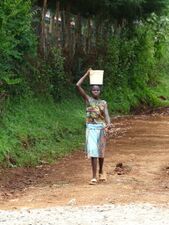Clean water for 442 households in Kenya: Difference between revisions
(Created page with "{{Project |Description=Clean water is essential for good health. Right now 55% of households across Kericho county, Kenya have to use dirty water from rivers and ponds. Access to clean water and good sanitation is a basic human right. This project will support 2 key areas - protection schemes for 4 natural spring water sources serving 442 households with a population of 2,260 and protecting childrens' health in over 300 schools through provision of rain water harvesti...") |
No edit summary |
||
| Line 16: | Line 16: | ||
# https://www.youtube.com/watch?v=nrll79ppXso | # https://www.youtube.com/watch?v=nrll79ppXso | ||
# https://www.youtube.com/watch?v=dAAd_Fndt-0 | # https://www.youtube.com/watch?v=dAAd_Fndt-0 | ||
=Project Gallery= | |||
|Problems=48826 | |Problems=48826 | ||
Revision as of 01:42, 24 May 2023
| Organization | Brighter Communities Worldwide |
|---|---|
| Region | Kenya |
| Website | Website |
| ProjectLeader | Rose Hennessy |
| Linked Problems & Solutions
|
|---|
Clean water is essential for good health. Right now 55% of households across Kericho county, Kenya have to use dirty water from rivers and ponds. Access to clean water and good sanitation is a basic human right. This project will support 2 key areas - protection schemes for 4 natural spring water sources serving 442 households with a population of 2,260 and protecting childrens' health in over 300 schools through provision of rain water harvesting, toilets and handwashing stations.
Challenge
The only way families can get water for drinking, cooking and cleaning is to collect from ponds, streams, rivers that are contaminated by animal waste and water borne diseases such as cholera and typhoid. Babies and children under 5 are especially at risk if they get sick. Girls and women have to walk 6km, at least once every day to collect water. Hours spent on this are at the expense of time at school or work. This project delivers solutions for households and schools with community input.
Long-Term Impact
Putting protection structures in place at water sources prevents animal contamination and protects the area keeping it safe for collecting water and ensuring future sustainability. All projects practice cost-sharing with communities contributing either financially or with labour and households pay a small fee in group schemes - this ensures the projects are owned by the community and sustainable in the long term. Education on sanitation and hygiene is included across all community workshops.
References
- https://www.brightercommunities.org/en/index.php
- https://www.brightercommunities.org/en/index.php
- https://www.youtube.com/watch?v=nrll79ppXso
- https://www.youtube.com/watch?v=dAAd_Fndt-0
Project Gallery








